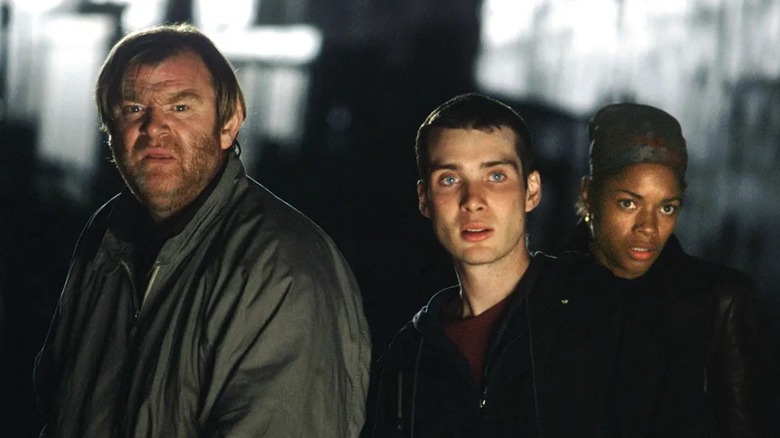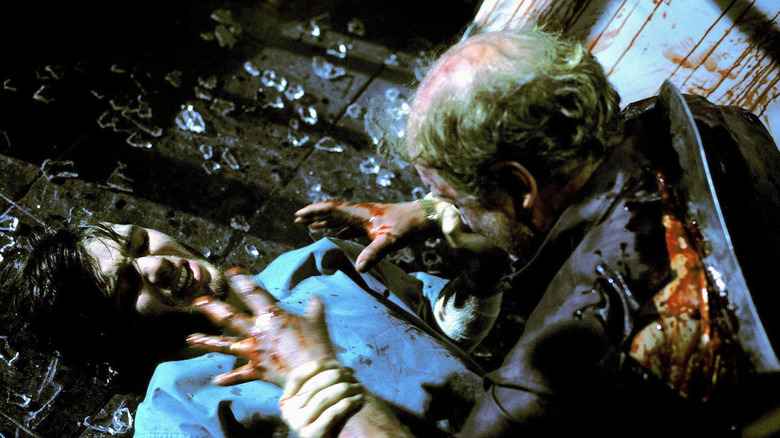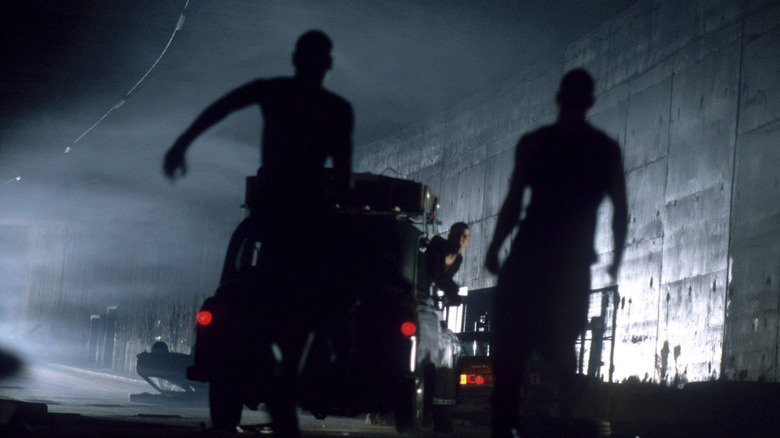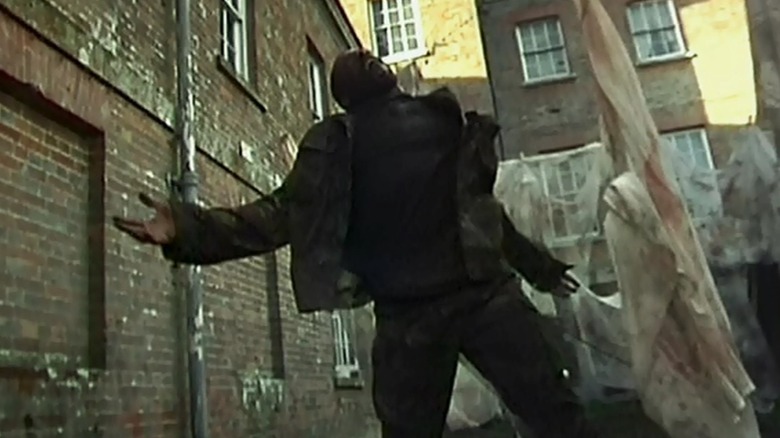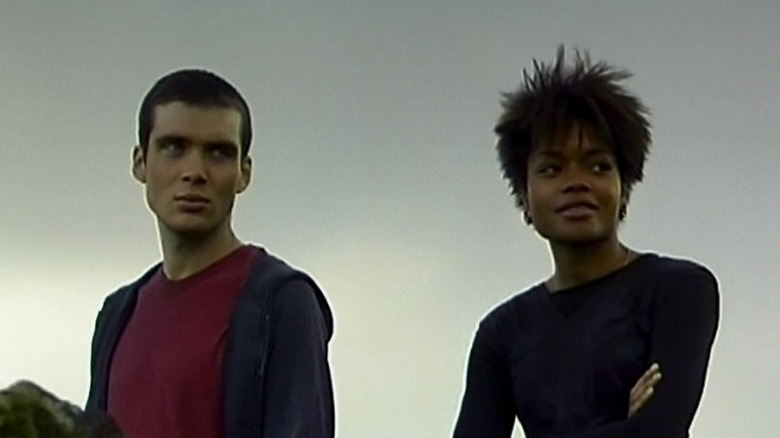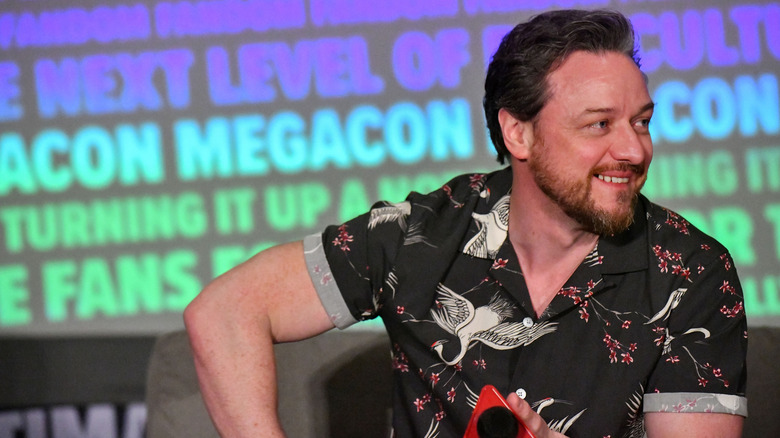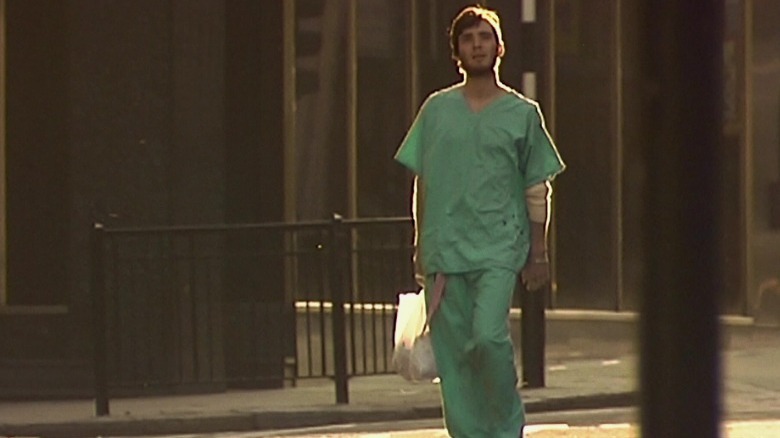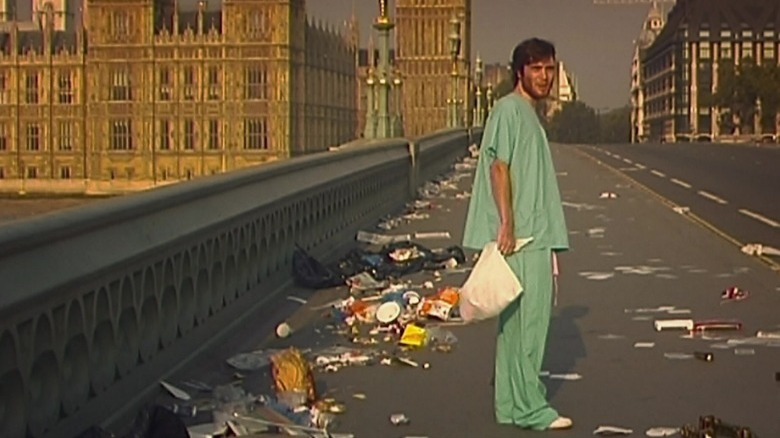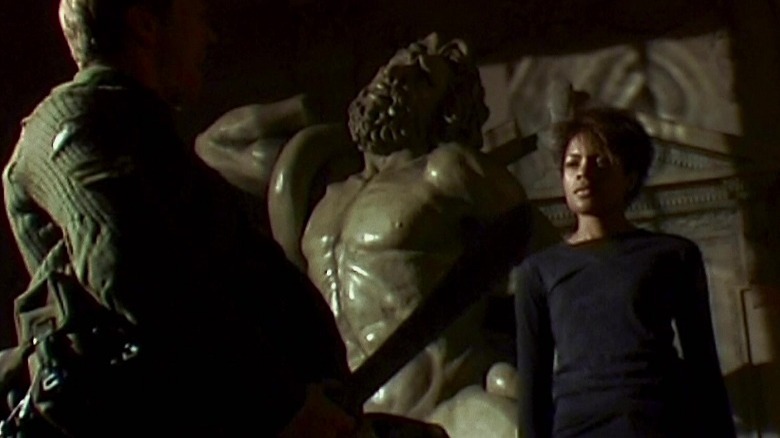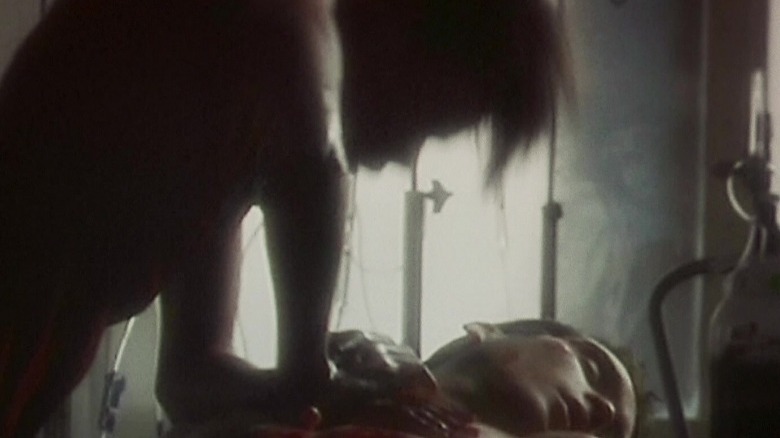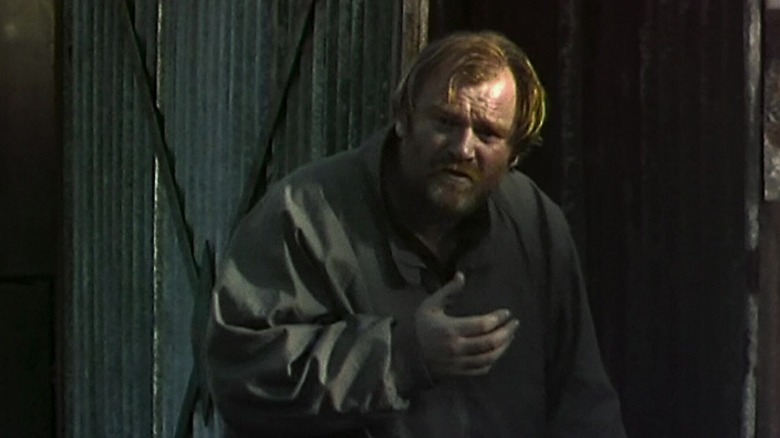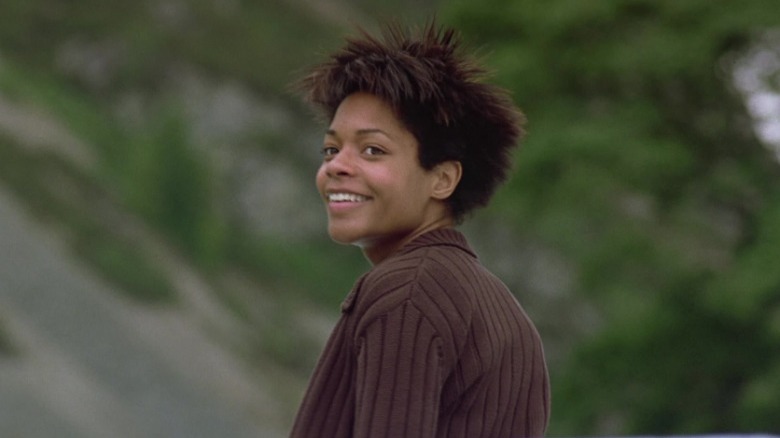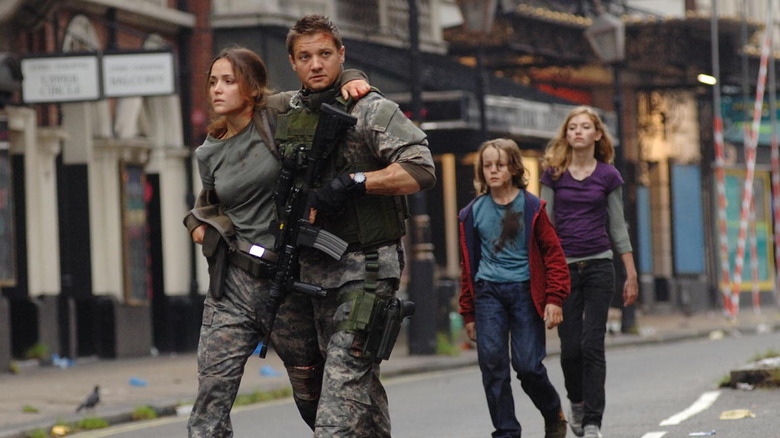The Untold Truth Of 28 Days Later
It may be easy to overlook after the long-running success of AMC's "The Walking Dead," but zombies weren't always so popular with mainstream moviegoers. Ever since George A. Romero introduced us to the genre, zombie flicks have always pleased the horror crowd. But it wasn't really until the 2000s, with the rise of "Shaun of the Dead" and Robert Kirkman's "The Walking Dead" comics, that the general public begin clamoring for a bite of human flesh. Suddenly, zombie fever began to spread like ... well, like a zombie epidemic, and the film "28 Days Later" was arguably Patient Zero.
You may know that this low-budget indie horror movie became a huge hit, but did you also know how the film crew managed to get all those creepy shots of an empty London without building the city on a soundstage? What about the unlikely inspiration for the zombies, or the mythological references hidden in the movie? Only the most dedicated fans will know that there are not one but three alternate endings, each of them much darker than the theatrical version. Below we've compiled some fascinating facts that you probably didn't know about "28 Days Later."
The director insists it's not a zombie movie
While "28 Days Later" is considered one of the best zombie movies of all time, there is some debate about whether or not it is technically a zombie movie. The victims of the Rage Virus are not called "zombies" but instead the "Infected." Here, the Infected don't hunger for human flesh, and it's unclear if they are even undead.
Even the director himself doesn't necessarily consider it as a zombie flick. The film's composer, John Murphy, told The Telegraph that director Danny Boyle only described the movie as a "zombie movie" once, when he was first pitching the project, and then never used that label again. "Danny was just trying to make the best film he could," said Murphy, "and, for me, it was more of an apocalyptic road movie." The filmmakers were influenced not only by zombie movies but also sci-fi stories like John Wyndham's "The Day of the Triffids."
In an interview with Inverse, Boyle admitted, "I'm not a zombie fan, to be absolutely honest." He was hesitant to market it as a zombie film because it was so different from anything else in the genre. "We were very worried about people thinking it was a zombie movie," he told Filmmaker magazine, "because I think if you're a zombie fan, you'll be disappointed." Boyle needn't have worried, because "28 Days Later" performed amazingly well at the box office.
28 Days Later didn't invent fast zombies, but it popularized them
At a glance, "28 Days Later" may seem like it was the first horror movie to introduce the trope of fast zombies, but in fact fast zombies predate the film by two decades.
The first horror movie to feature fast zombies was actually Umberto Lenzi's 1980 film "Nightmare City." However, just like "28 Days Later," they aren't technically zombies. These creatures are far from braindead, and the heroes soon discover the zombies are capable of shooting firearms. In addition, there was the 1985 movie "The Return of the Living Dead," which also had zombies who were fast on their feet. Like "Nightmare City," the shambling undead here are smarter than the average zombie; one even picks up a police radio and says, "Send more cops."
Even if "28 Days Later" didn't create the first fast zombies, it certainly made them popular. Outside of "Nightmare City" and "The Return of the Living Dead," the zombie movies of the era depicted only the shuffling variety. By the '90s, the zombie genre had all but dropped dead, eclipsed instead by a much sexier undead creature: vampires. With "28 Days Later," however, the genre finally began to climb out of its grave. This independent (albeit very lucrative) film paved the way for mainstream zombie success with later works such as "I Am Legend" and "The Walking Dead."
The zombies were inspired by road rage – and rabies
The zombies from "28 Days Later" seem like they've staggered out of a nightmare, but the filmmakers actually found inspiration for these creatures a little closer to home. In an interview with NME, Danny Boyle explained that he hoped the zombies would capture "that moment of incandescent murderous fury that you have when you're driving a car and you just lose it." In other words, it's like road rage — except the zombies from "28 Days Later" are raging nonstop.
Boyle also borrowed from real-life diseases when designing the Rage Virus, saying it was primarily inspired by Ebola along with aspects of rabies. Observant viewers will notice that the first signs of zombification — red eyes, violent hemorrhages — also happen to be symptoms of Ebola. In fact, the specter of Ebola was looming in the public consciousness around when the movie was released, since there had been a deadly Ebola outbreak in Uganda in 2000. The zombies in "28 Days Later" simply brought that fear to life.
In particular, the filmmakers were fascinated by hydrophobia, a behavior that often appears in rabies patients. "[We had] photos from the 1930s of people dying with rabies," Boyle told NME, "and they're being approached with a bowl of water and the expression on their face when they see this water is absolutely terrified." Boyle and his team tapped into this same primal urge when deciding how their zombies would look and move.
The director didn't want any stars in his movie
It's easy to take for granted that Cillian Murphy and Naomie Harris are now well-known for their work on franchises like the "Dark Knight" trilogy and the James Bond movies. Yet when Danny Boyle recruited them for "28 Days Later," they were hardly big names. Before "28 Days Later," Murphy had mostly done short films, while Harris was known primarily for her work on children's TV shows like "The Tomorrow People." Both actors were relative unknowns, and that was just how Boyle liked it.
If Boyle had cast some already-famous actors, then Fox Searchlight Pictures might have given him a bigger budget, but he chose to work with what he had. "We did that because we didn't want any stars in it," Boyle explained to Filmmaker magazine, adding, "We wanted it to be just ordinary people." This fit perfectly with the movie's realistic, low-key aesthetic. If the cast members weren't famous faces, then it would be easier for audiences to see themselves in the characters — and wonder if these characters would even make it to the end of the movie.
In retrospect, Boyle considers the low budget a blessing, because it challenged him to come up with more creative solutions. "Not having the money can be a problem or it can be a kind of freedom, and for us it was a freedom," he concluded.
James McAvoy auditioned to play a zombie
While "28 Days Later" may have given a boost to two up-and-coming actors, there is one that the filmmakers passed over: James McAvoy, who auditioned for a part in the film. The actor had been jazzed to get the part, which would have been one of his first roles in a feature film, but his enthusiasm dampened when he learned that his role wasn't quite as big as he'd been expecting. "I thought I was going up for one of the leads but it actually transpired that I was actually reading for a 'featured zombie,'" McAvoy shared in an interview with GQ.
When he was auditioning for the part, McAvoy mentioned on his CV that he had some experience with acrobatics. The director asked him to demonstrate a backflip, and like an obedient zombie, McAvoy showed him. As McAvoy later discovered, the director was "trying to figure out how the zombies might move." But McAvoy's backflip must not have been what Boyle was looking for, because the actor never got the part.
Luckily, McAvoy got another opportunity to work with Danny Boyle years down the line, in a film called "Trance." ("Finally won him over!" McAvoy told Movies.ie.) Of course, McAvoy is convinced that Boyle didn't even recognize him as the zombie guy from "28 Days Later" until he told the director on the set of "Trance" that they had already met.
The movie was designed to look like real news footage
If "28 Days Later" gives off an almost photo-realistic vibe, that's because many scenes from the film were designed to resemble real-life photos and news footage. Screenwriter Alex Garland told Filmmaker, "We deliberately referenced images from news footage throughout the film." He explained that the gas station explosion was modeled after a bombing in Northern Ireland, while the bodies piled up in the church drew from something that actually happened during the Rwandan genocide.
According to Garland, the scene where the soldiers try to execute Jim (Cillian Murphy) contains a shot that mirrors a photo of an execution in Bosnia. Danny Boyle added, "There's one point when [the protagonist] picks up all the money on the steps outside Buckingham Palace, and that's from a very famous photograph taken after the Khmer Rouge abandoned Phnom Penh. The streets of this deserted city were literally covered in money."
However, there is one detail from "28 Days Later" where reality imitated fiction instead of the other way around. The attack on the World Trade Center happened during the film's production, leaving the cast and crew shaken. Suddenly, a scene that they had already shot (a wall plastered with photographs of the missing) took on a whole new meaning. The director had originally based that detail on photos he'd seen from the aftermath of an earthquake in China, but in the wake of 9/11, it was hard to associate the image with anything else.
The crew could only stop London traffic for a few minutes at a time
How did the crew of "28 Days Later" film the exterior scenes in London? They couldn't exactly rent out the entire city for an afternoon to use in their movie, and they didn't have the budget to build a whole cityscape on a soundstage.
"We couldn't do deserted London in a realistic way," explained Danny Boyle to Filmmaker, "because after a catastrophe like this, there'd be burnt-up cars, there'd be bodies everywhere, and we could only just get permission to stop traffic for just a couple of minutes at a time." So the filmmakers found a creative workaround that actually fit the film perfectly. Rather than building a London that looked like a war zone, they simply chose to show the city eerily empty.
Since the crew could only stay at each location for a few minutes — lest London commuters begin cussing them out — they used a trick in the editing room to make their post-apocalyptic London seem more expansive than it actually was. At each location, the filmmakers would keep 10 cameras rolling at once. Boyle told RES Magazine (via Scraps from the Loft), "We'd choose the angles, set them up very carefully so we knew that when we cut them together it would make you feel like it was rolling on and that you were walking around the city with him and there was no one there."
Major West's statue has symbolic meaning
The mansion of Major West (Christopher Eccleston) is decorated with the famous sculpture "Laocoön and His Sons," and this is no coincidence. Roman history expert Penelope Goodman explained on her blog that the statue depicts a myth in which the gods sent serpents to punish Laocoön for disobeying their will. Since the film begins with scientists "playing God" by experimenting on chimpanzees, it could be argued that the Rage Virus is also a form of divine punishment. Others have speculated that Laocoön is meant to embody human endurance, since Laocoön is entangled in serpents that are just as deadly as the zombies, yet is still fighting to the bitter end.
According to some versions of the myth, the serpents killed Laocoön for trying to warn the Trojans that a certain wooden horse was not what it seemed. In fact, Laocoön is famous for saying, "I fear the Greeks even bearing gifts." So the statue is a fitting choice. Major West's mansion, which seems like the last stronghold against the zombies, may call to mind the siege of Troy, observes Goodman, and we all know how that ended. Alternatively, this setting could be viewed as the Trojan Horse, since the mansion lulls the protagonists into a false sense of security — but of course, it's too good to be true. Some fans have suggested that the statue foreshadows the twist about Major West. That's a pretty elaborate literary reference for a zombie movie.
The filmmakers shot two alternate endings
The ending of "28 Days Later" concludes the story on an upbeat note, but it wasn't always this way. In one unused alternate finale, Selena (Naomie Harris) and Hannah (Megan Burns) rush Jim to an abandoned hospital after he rescues them from the soldiers. (Brief fragments of this sequence actually appear in the final film, as flashbacks that explain how Jim ended up in the farmhouse.) Unlike in the theatrical version, however, Selena is unable to save Jim.
Once Selena finally accepts that Jim is gone, she tells Hannah that there's nothing else they can do but keep moving. In this version, Jim comes full circle, landing in a hospital bed once more. This alternate ending was actually attached to the film when it played on certain TV channels; it was included as a post-credit sequence, introduced by a title card that read "What If?"
Meanwhile, a second alternate ending plays out almost exactly like the final film, with the characters stitching together sheets to catch the attention of a passing jet. Yet there is one key difference: Jim is nowhere to be found. Instead, it's just Selena and Hannah; the implication is that Jim died from his wounds offscreen. In place of Selena's dialogue with Jim, we see Selena talking to a chicken. In the audio commentary accompanying this bonus feature, Danny Boyle joked, "The chicken did the shot in one take," adding that he didn't know "how many times Cillian could claim that."
Danny Boyle storyboarded a radically different alternate ending
There was actually a third alternate ending to "28 Days Later," but Danny Boyle never got a chance to film it. He did, however, storyboard the sequence and create an animatic for it.
This alternate ending would have changed the last 45 minutes of the movie, everything after Frank (Brendan Gleeson) gets infected. Rather than killing Frank in this version, Jim ties Frank up and keeps him alive, because he still hopes that the people who sent out the broadcast might know a way to cure him. The heroes discover that the broadcast had been sent by Major West and his soldiers, but the men were all killed by zombies. The only survivor is a cynical man who has locked himself away in a bunker. He knows how to cure Frank, though he warns the heroes that there's a catch: they must give Frank a blood transfusion — not just a pint, but enough blood to replace every drop in Frank's body.
As Danny Boyle explained, this made no sense, since the film had already established that you could get infected with a single drop of blood. "What do you do," said Boyle, "clean out every capillary and vein with bleach before making the transfusion?" Nevertheless, the filmmakers still storyboarded the rest of that ending, with Jim sacrificing himself to successfully save Frank. Funnily enough, this would have been the second alternate version to end with Jim in a hospital bed.
Selena's story continues in a comic book sequel
The sequel "28 Weeks Later" does not continue the story of Jim and Selena, instead following an entirely new cast of characters. Luckily, for fans who want to know Jim and Selena's fates, there is a comic book series that answers this question: "28 Days Later" by Michael Alan Nelson and Declan Shalvey.
Taking place between "28 Days Later" and "28 Weeks Later," the comic follows Selena after the events of the first movie. Jim has been arrested for killing Major West, while Hannah has been placed in foster care by her rescuers. Meanwhile, Selena ends up in a Norwegian refugee camp. With the outbreak contained in the British Isles, a journalist named Clint asks Selena to be his guide when he ventures into the quarantine zone. Selena is incredulous that anybody would want to return to the place she just barely escaped, yet the alternative is to let Clint walk into certain death, so she agrees to return. Naturally, things go horribly wrong.
Along the way, the comic fleshes out Selena's backstory, exploring her relationship with her boyfriend before the outbreak and revealing where she got her trusty machete. In an interview with Comic Vine, Nelson shared that it was exciting trying to expand the world of "28 Days Later" while still adhering to the canon established in the movies. "I'm playing in someone else's sandbox," he said, "but I'm still building my own sand castle."
28 Months Later is still a possibility
Since "28 Days Later" was followed by "28 Weeks Later," fans naturally can't help but wonder if "28 Months Later" will ever happen. After all, talk of the possible sequel began as early as 2007. Cillian Murphy said in 2022 that he would be game for playing Jim again, though he pointed out that since two decades have passed, his character would be a lot more than 28 months older.
Screenwriter Alex Garland might need a little more convincing. "'28 Days Later,' when it arrived, was kind of fresh," he told Yahoo! in 2022. "And I don't think it's fresh anymore." Since writing the script for "28 Days Later," Garland has moved to the director's chair, helming films such as "Ex Machina" and "Annihilation." Danny Boyle told The Playlist, "We might have to work hard to get him to write it, unless he wanted a break from [the] directing process."
Still, there's hope yet that the team could reunite for the sequel. Boyle confirmed to NME that Garland did write a script for "28 Months Later," and Boyle said he might consider returning to direct. He added, "It's funny, I hadn't thought about it until you just said it, and I remembered 'Bang, this script!' which is again set in England, very much about England." This may tell us a little bit about what the sequel might entail — if it ever happens.
